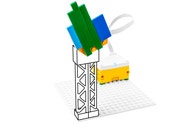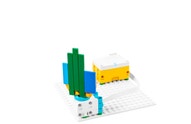SPIKE™ Essential
Good Morning Machine
Help Leo say ‘good morning’ to his friends!
30-45 min.
Beginner
Years 3-5

Prepare
- Review the Good Morning Machine lesson in the LEGO® Education SPIKE™ App.
- If you feel that it would be beneficial, pre-teach these related vocabulary words: challenge, create, innovate, program, test and upgrade.
- Consider the abilities and backgrounds of all your pupils. Differentiate the lesson to make it accessible to everyone. Please refer to the Differentiation section below for suggestions on how to do this.
- If time permits, plan and facilitate the language arts extension. Please refer to the Extension section below for further information.
Engage
(Whole Class, 5 Minutes)
- Facilitate a quick discussion about the process of identifying the steps that must be followed in order to solve a problem.
- Talk with your pupils about what they'd do if they had to reach something that was too high.
- Ask questions like these: What would you do first? What would happen after that?
- Introduce your pupils to the story’s main characters and the first challenge: starting the waving machine for Leo.
- Distribute a brick set and a device to each group.
Explore
(Small Groups, 30 Minutes)
- Have your pupils use the LEGO® Education SPIKE™ App to guide them through their first challenge:
- Create and test the program that starts the waving machine.
- Have your pupils iterate and test their models to complete the next two challenges in the app:
- Upgrade the program for the waving machine.
- Design your own waving machine.
- You can find coding and building help in the Tips section below.
Explain
(Whole Class, 5 Minutes)
- Gather your pupils together to reflect on their completed challenges.
- Ask questions like these: What was Leo’s problem? How did you help him to solve it? How did you improve Leo’s waving machine?
Elaborate
(Whole Class, 5 Minutes)
- Prompt your pupils to discuss and reflect on ways of defining and understanding a problem.
- Ask questions like these: Why is it important to understand the problem you’re trying to solve? What types of questions should you ask to find out more about the problem?
- Have your pupils tidy up their workstations.
Evaluate
(Ongoing Throughout the Lesson)
- Ask guiding questions to encourage your pupils to ‘think aloud’ and explain their thought processes and reasoning in the decisions they’ve made while building and programming their models.
Observation Checklist
- Measure your pupils’ proficiency in defining and understanding the given problem.
- Establish a scale that suits your needs. For example:
- Requires additional support
- Can work independently
- Can teach others
Self-Assessment
Have each pupil choose the brick that they feel best represents their performance.
- Yellow: I think that I can define and understand the problem.
- Blue: I can define and understand the problem.
- Green: I can define and understand the problem, and I can also help a
friend to do it.
Peer Feedback
- In their small groups, have your pupils discuss their experiences of working together.
- Encourage them to use statements like these:
- I liked it when you…
- I'd like to hear more about how you…
Tips
Coding Tips
- After your pupils have completed their first challenge, they'll be provided with three Inspiration Coding Blocks, which will help them to modify their programs.
- The Inspiration Coding Blocks are intended to spark their imaginations as they experiment to find their own solutions.




Model Tip
- After your pupils have completed their second challenge, they’ll be provided with three Inspiration Images and an open-ended prompt, which will help them to improve their models.
- The Inspiration Images are meant to help spark their imaginations as they experiment and personalise their models.




There are no specific building instructions for this challenge.
Differentiation
Simplify this lesson by:
- Selecting one Inspiration Image to help your pupils personalise their models
- Experimenting with either the coding or the building
Increase the difficulty by:
- Exploring new and different Coding Blocks in the program
- Including another motor or sensor in the waving machine's design
Extension
- Have your pupils conduct a short research project about how people from different cultures greet each other in the morning.
If facilitated, this will extend beyond the 45-minute lesson.
Language Arts: National Curriculum English En5/2.2 Comprehension b
Teacher Support
The pupils will:
- Define and understand a problem
- Brainstorm and iterate in order to create a solution that meets the described needs
- Engage effectively in a range of collaborative discussions
(one for every two pupils)
- LEGO® Education SPIKETM Essential Set
- Device with the LEGO® Education SPIKE™ App installed
National Curriculum
Design and technology
DT2/1.1b
- generate, develop, model and communicate their ideas through discussion, annotated sketches, cross-sectional and exploded diagrams, prototypes, pattern pieces and computer-aided design
DT2/1.3b - evaluate their ideas and products against their own design criteria and consider the views of others to improve their work
English
En5/1g
- use spoken language to develop understanding through speculating, hypothesising, imagining and exploring ideas
En5/2.2b
understand what they read by - checking that the book makes sense to them, discussing their understanding and exploring the meaning of words in context
- asking questions to improve their understanding
- drawing inferences such as inferring characters' feelings, thoughts and motives from their actions, and justifying inferences with evidence
- predicting what might happen from details stated and implied
- summarising the main ideas drawn from more than 1 paragraph, identifying key details that support the main ideas
- identifying how language, structure and presentation contribute to meaning




